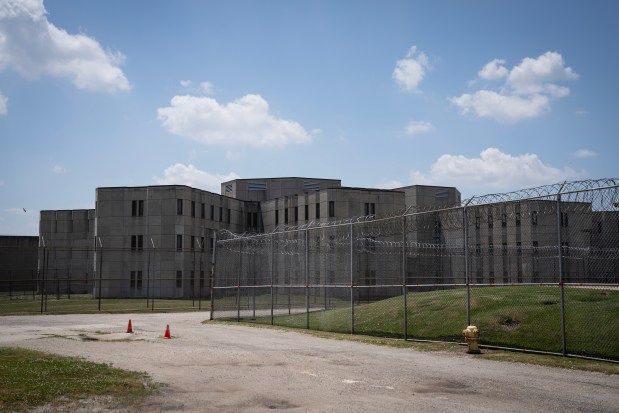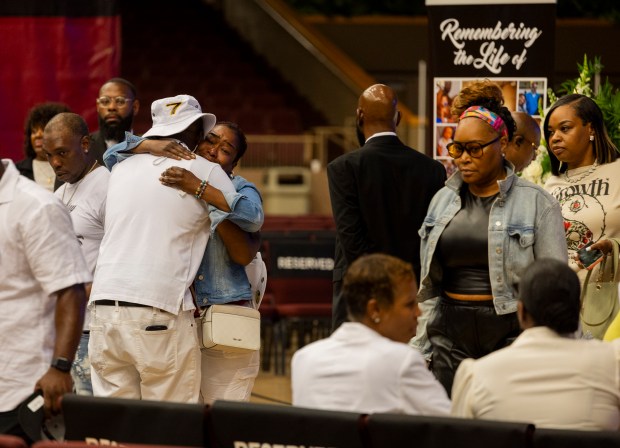Dozens of men have begun to be transferred out of Stateville Correctional Center just north of Joliet as debates continue over the condition of the century-old prison and Gov. JB Pritzker’s plans to rebuild it in the coming years.
So far, 75 people in custody have been transferred out of Stateville, Illinois Department of Corrections spokesperson Naomi Puzzello said Wednesday. Those men went to prisons across the state, according to Anders Lindall, a spokesperson for American Federation of State, County and Municipal Employees Council 31, which represents many employees at the maximum-security correctional facility.
The transfers mark a significant step and a slight speed-up in plans regarding Stateville and other Illinois prisons as advocates for those who are incarcerated and employees at prisons have raised a broad range of sometimes differing concerns.
A federal judge earlier this month ordered most Stateville inmates be moved out by Sept. 30 after civil rights lawyers argued the conditions were too hazardous. As of the end of June, IDOC reported Stateville’s total population was 568.
The ruling by U.S. District Judge Andrea Wood came about five months after the Pritzker administration said it planned to rebuild Stateville in Crest Hill and Logan Correctional Center in downstate Lincoln as part of a nearly $1 billion project.
Outcry over the welfare of those incarcerated at Stateville and at other Illinois prisons grew louder among advocates this summer after the June death of 51-year-old Michael Broadway, who died in Stateville during a severe heat wave. Advocates put at least part of the blame for Broadway’s death on the heat and squalid conditions inside the prison. Those conditions include poor ventilation, visible mold, rodent infestations and unsanitary drinking water. Broadway’s autopsy report has not been released.
As IDOC has begun moving those at Stateville to other facilities, state officials have continued working on plans to demolish and rebuild the prison.
The Illinois Department of Corrections and the state Capital Development Board, which oversees the design and construction of state facilities, have tapped the Chicago engineering and construction firm CDM Smith to assess the Stateville site, Puzzello said in an email.
That firm found the site “can accommodate two new correctional facilities,” Puzzello said, in line with the department’s proposal to put both Stateville and Logan, which is a prison for women, at the same general location.
Before Wood ordered officials to move most people out of Stateville by the end of September, state officials had said they were not expecting to wind down operations at the maximum-security prison until at least that month, if not later, and that the rebuilding plans would take three to five years.
Civil rights lawyers representing people incarcerated at Stateville filed the motion in July for a relatively quick transfer or release of people at Stateville as part of 2013 litigation over the prison’s conditions. The motion, from the firm Loevy & Loevy, described, among other things, bad-smelling drinking water and “bird feathers and excrement” covering floors, beds and sinks.
In granting the lawyers’ request for a preliminary injunction, the judge found “a probable risk of irreparable harm from falling concrete” in many areas.
“Our anticipated timeline for transfers of individuals in custody is in line with the order issued by the court. Our priority is ensuring the safety and security of everyone involved during the transfer process, which prevents us from disclosing the specific date of transfer for individuals or groups,” Puzzello said earlier this month.
“There are no plans to depopulate Logan Correctional Center until the rebuild is complete,” she said in an email Wednesday.
Lindall of AFSCME said individuals transferred out of Stateville in the past few weeks were expected to go to Shawnee Correctional Center, Centralia Correctional Center, Western Illinois Correctional Center, Danville Correctional Center, Big Muddy River Correctional Center, Graham Correctional Center and Jacksonville Correctional Center. All of those are medium-security prisons except for Jacksonville, which is minimum security.
IDOC has indicated to AFSCME that transfers of about 35 to 45 people will continue twice per week to other minimum-, medium- and maximum-security facilities, Lindall said.


Advocates for people who are incarcerated rallied outside the Illinois government’s main building in Chicago last month to protest prison conditions and called attention to Broadway’s death. Broadway was a graduate of the Northwestern Prison Education Program, and the protest attracted dozens of advocates, friends and family members.
Stanley Howard, who spent 16 years on death row and was later exonerated by Gov. George Ryan, said unlivable prison facilities need to be closed down.
“It’s inhumane. We can do better. Shut it down,” Howard said at the rally.
At a service for Broadway at the House of Hope venue in Pullman, friends and family celebrated Broadway’s accomplishments while also preparing to fight against the prison conditions he experienced.
“The reality is that he’s gone, but has brought a lot of people together to try to close Stateville, to try to make conditions better. And I know that again, Michael’s legacy, if it could be anything, is that his passing will cause the closure of Stateville, his passing will then bring light to the criminal justice system,” Jimmy Soto, a former classmate of Broadway in the prison education program, said after the service in early July. Soto was incarcerated for more than 40 years after being wrongfully convicted and was released from prison last year.
AFSCME, the main union speaking out about Stateville’s rebuilding process, has an overlapping but different set of concerns. Lindall said the union is worried about employee safety as IDOC sends people in custody to medium-security facilities that he described as understaffed.
The union has supported building a new prison while arguing that the current Stateville be repaired but remain open during construction.
The union also has expressed concerns about potential service disruptions and how people being transferred to facilities that are much farther away from the Chicago area will receive visits from family and friends.
“Yes, a new Stateville is needed, but there’s a way to do it without this kind of disruption,” Lindall said.
Tribune reporter Jeremy Gorner contributed.




